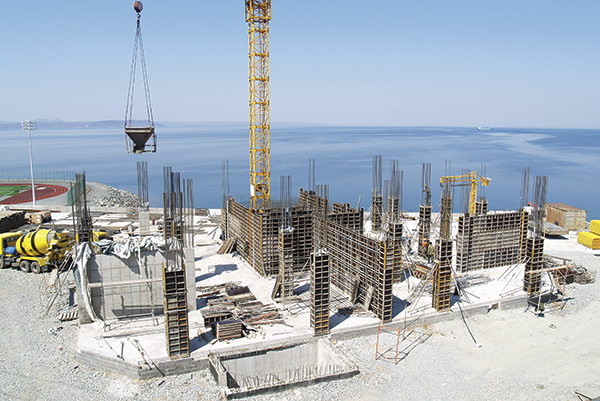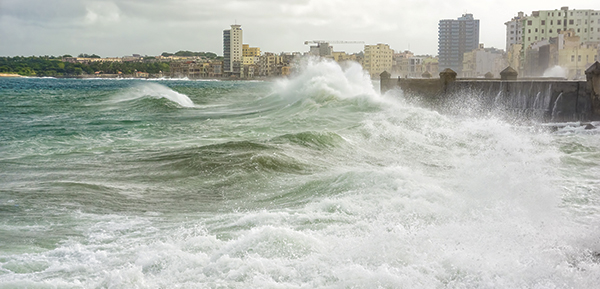When dealing with a construction site that is underwater or where the water table is just above sea level, contractors must ensure that the excavation stays dry and safe for workers. This can be even more challenging in locations with conditions affected by water depth and complications like silt and sand.
Additionally, these difficult conditions may vary during seasonal weather or with the tides. Contractors need to investigate historical data and monitor fluctuations in water levels and speeds of flow to decrease the risks for workers and ensure the success of the project.
The contractor must decide what pumping equipment to use based on the hydraulic conditions. Jobsite conditions—such as flow required to mitigate water seepage, depth of a coffer dam and solids content—influence this decision. The contractor usually chooses between self-priming centrifugal pumps or submersible pumps.
Self-Priming Centrifugal Pumps
One weakness of end-suction centrifugal pumps is their poor performance when the liquid is below the pump centerline. Liquid must be delivered to the pump so the process can begin. Air on the suction side of the pump (the piping and pump casing) needs to be completely evacuated. If any air remains in a centrifugal pump, the pump becomes air bound and incapable of functioning.
 Dewatering pumps keep construction sites dry in high water table areas. (Article images courtesy of BJM Pumps.)
Dewatering pumps keep construction sites dry in high water table areas. (Article images courtesy of BJM Pumps.)The self-priming centrifugal pump, a specialized end-suction design, creates a vacuum at the impeller eye to continuously remove air from the suction line. The pump cannot compress the air during the priming phase, so the air must be allowed to escape through the discharge. As air is removed, atmospheric pressure forces water through the suction piping to the pump, allowing the pump to operate.
This self-priming process occurs automatically once the pump is started with the initial quantity of liquid. Sand or solids in the pumped liquid can complicate the priming process. The practical suction lift limit for self-priming pumps is about 8 meters (26 feet) of liquid under ideal conditions.
Self-priming centrifugal pumps have disadvantages. Any small vacuum leak—such as sealing areas around connectors in the suction line or pump seals—can prevent the unit from priming.
The pump will continuously pull air from the leak instead of the air in the suction line, which keeps the priming cycle from being completed. These leaks are a common cause of priming failure. They can be very small or invisible to the naked eye but still prevent priming.
The diameter and length of the suction hose or pipe can also affect the priming cycle’s length of time because of the volume of air that must be evacuated during pump priming. This extended priming time can also add heat to the liquid, which further extends prime time.
Self-priming pumps need to be as close as possible to the water source. A location directly above the coffer dam with few restrictions reduces friction. This can present problems, depending on the excavation location.
Once the pump is primed and moving fluid, it will require adequate net positive suction head (NPSH) to continue pumping without suction limitations.
Without sufficient NPSH, a self-priming centrifugal pump can experience cavitation and lose prime. Lifts through long suction lines, especially lines containing obstructions, can be plagued by cavitation problems that cause unacceptable noise levels and possible equipment damage.
If a self-priming pump must lift water 15 feet or more from the source to the pump’s suction, the pump capacity could be decreased significantly.
Most self-priming centrifugal pumps in remote applications have engine drives. These drives can present their own operational issues—such as maintaining fuel levels for long run times, the engine oil condition and other prime mover maintenance issues.
Submersible Pumps
Submersible pumps offer many operational and application advantages. These pumps are submerged directly into the water for immediate use and unit cooling. This eliminates priming challenges and extended prime times.
No worker intervention is required. The pump is fed without the need for a suction line.
Submerged pumps are quiet. Cavitation is rare and occurs primarily when the sump is too small for the installed submersible pump’s size. They are also lighter weight and portable.
The versatility and low maintenance of submersible pumps make them an ideal option for dewatering service. No regular maintenance is necessary.
Submersible pumps usually need to be fully submerged. The water around a submersible pump actually cools the motor.
Case Study: Reconstructing Galveston
The sea level along the Gulf Coast is rising faster than most places on the globe. Galveston, Texas, has experienced a 3-foot rise since the disastrous flood of 1900 that killed thousands of people.
One of the toughest jobs in rebuilding the infrastructure of a city that is just a few feet above sea level is keeping water out of the construction site—particularly water that is laden with sand. Pumping a water/sand slurry is tough on pumps, especially aluminum dewatering pumps. Boyer Construction experienced this condition while working in Galveston.
Galveston Island, located in Southeast Texas, runs west to east and is slightly tilted to the northeast end, where the city of Galveston is located. The north side of the island opens up to a protected harbor, and the southern side faces the Gulf of Mexico.
Before the 1900 hurricane— which still holds the record of the most deadly natural disaster in American history with 6,000 deaths—the highest point in Galveston was 9 feet above sea level.
After the 1900 hurricane, a 17-foot high, 3-mile long seawall was built to protect the city and its people from other storms. The entire city was raised to the edge of the seawall. Then the island was sloped down 8 feet above sea level on the north side, so that water rising over the seawall would drain into the bay. This engineering feat, which took more than 10 years, was accomplished by pumping a sand and seawater slurry under existing buildings to raise the island. The seawater ran off, leaving the sand and building up the island. Since then, Galveston has experienced other hurricanes, but none have had the same impact as the great 1900 storm.
In September 2008, Hurricane Ike devastated Galveston Island along with the Bolivar Peninsula and Gilchrist, Texas, with sustained winds of 110 miles per hour, and a 22-foot storm surge. Property damage was estimated at $29.5 billion, and 135 people died in the U.S. because of the storm. The downtown area of Galveston had 6 feet of standing water in the aftermath.
As is always the case after a hurricane impacts a populated area, the rebuilding and damage-repair effort took years of hard work and millions of dollars. One of the companies that worked to rebuild Galveston was Boyer Construction.
 A storm surge attacks a seawall that protects a coastal city.
A storm surge attacks a seawall that protects a coastal city.Boyer Construction is a 20 year-old construction and engineering company specializing in civil, electrical, mechanical and inland marine construction projects. Based in northwest Houston, more than 250 engineers, master electricians and plumbers, equipment specialists, and skilled fabricators, have worked on rehabilitation and infrastructure replacement projects throughout southeast Texas.
Many of those projects, including those in Galveston, required dewatering pumps on coffer dams and large excavation jobs. These demanding services require continual operation, pumping water that is often laden with silt and sand. The combination of continual cycling with salt and brackish water minimizes the life of most dewatering pumps.
Looking for help in keeping their dewatering pumps from wearing and failing, Boyer Construction contacted a pump specialist. The expert recommended a series of hard metal dewatering pumps.
The chosen pump offered the flow range and high lifts required for a broad spectrum of applications. From 2 horsepower with flows up to 180 gallons per minute (gpm) and heads up to 55 feet to 10 horsepower with flows up to 475 gpm and heads up to 117 feet, the series of pumps is designed and constructed for harsh services. The impeller and wear plate are made of abrasion resistant chrome iron, while the agitator and volute are constructed of hardened ductile iron, making the pump appropriate for the salt/sand slurry and solids-laden water Boyer Construction would encounter. The integral agitator is designed to mix settled solids with pump water to maintain a steady solids concentration and discharge volume.
Conclusion
Every jobsite has a specific set of pumping conditions. Selecting the optimum pump for the service takes the collaboration of a competent contractor and a hydraulic specialist. The right choice of equipment can make a substantial impact on the timely completion of the project and the end user’s bottom line results.


